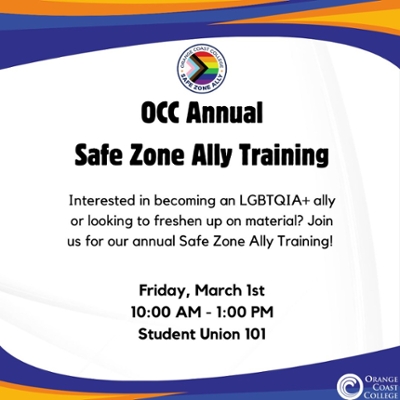Safe Zone Ally Training
If you're interested in becoming an LGBTQIA+ ally but don't know where to start, or would like to freshen up on LGBTQIA+ issues and identities, please join us on Friday, March 1st from 10:00 AM - 1:00 PM in the Student Union multipurpose room (101). Coffee & pasteries will be provided in the moring, and lunch will be served after our student panel. Please register below by Friday, February 23rd:
LGBTQIA+ Library Resources
"All resources in this guide are available through the OCC Library to students, staff and faculty. This is not an exhaustive list - there is much more to find on this topic in our collections!"
What are pronouns?
We first learn about pronouns in grade school, when we are taught that we use pronouns to refer to someone who's talking ("I" or "you") or someone we're talking about (she/her, he/him, they/them.) It just happens that what we may assume someone's pronouns are, isn't always correct.
Why do they matter?
Think about the number of times someone (family, friends, coworkers, etc) uses either your name or a pronoun to refer to you. Chances are it happens often, right? Imagine if people were using the wrong pronoun when talking to or about you. You might feel annoyed, hurt, or angry. It's important to use someone's asserted name and pronouns, not only to affirm their identity, but because it shows basic respect.
Pronoun Etiquette Tips:
- Create opportunities for people to share their pronouns with you rather than assuming you know their pronouns based on their appearance. For example, when introducing yourself share your pronouns like this:
-
In one-on-one conversation: “Hi, I’m John and I go by he/him. Nice to meet you.”
-
In a meeting: “Hi everyone. I’m Mollie. I’m the senior program manager and I go by she/her.”
-
In your e-mail signature next to your name: E. Wilson (pronouns: they/them/theirs)
-
-
If you don’t know someone’s pronouns, it’s okay to ask. You can say, “What pronouns do you use?” or “What pronouns do you go by?” or “What pronouns would you like me to use when I refer to you?”
-
Always use someone’s chosen (preferred) pronouns unless you’ve been asked not to do so for a specific reason (e.g., safety or privacy concerns).
-
Practice! Practice! Practice! It takes intention to consistently use someone’s correct pronouns if you previously used different pronouns for that person or if you’re using pronouns that are new to you. Take the time to practice referring to the person with the correct pronouns in conversation and in written communication. (Tip: Worried about misgendering someone in an email? Do a quick “CTRL+F” and search for any use of an incorrect pronoun before hitting send.)
-
If you make a mistake, apologize and move on (don't dwell.) Help others by gently correcting them if they misgender someone.
LGBTQIA+ Figures
Check out our collection of biographies on key LGBTQIA+ figures!
Audre Lorde LGBTQIA+ Activist (PDF)
Marsha P Johnson LGBTQIA+ Activist (PDF)
Crystal Jang LGBTQIA+ Activist (PDF)
LGBTQIA+ History Timeline in America
LGBTQIA+ history has celebratory historical events as well as events that continue to negatively impact the LGBTQIA+ community. In this timeline, we highlight some milestones for the community. If you'd like to check out a more extensive timeline, LGBTQhistory.org is great place to start.
1969 Stonewall Riots: Transgender and gender nonconforming people are among those who resisted arrest in a routine bar raid by police on June 28 on the Stonewall Inn in New York City’s Greenwich Village, thus helping to ignite the modern LGBT rights movement.
1973 DSM-III Removal: As a result of this scientific research, the American Psychiatric Association removed homosexuality from the DSM-III in 1973.
1982 Wisconsin Civil Rights Bill: Wisconsin passes the first lesbian and gay civil rights bill in the United States. The law prohibits bias in housing, employment, and public, accommodations.
1988 National Coming Out Day: The first National Coming Out Day is observed on October 11th to celebrate the one-year anniversary of the 2nd National March on Washington.
2008 Same Sex Marriage: The California Supreme Court rules same-sex couples have a constitutional right to marry. California becomes the second state in the U.S. to legalize same-sex marriages later that year. However, Proposition 8, which stated that marriage was between a man and a woman, passed with 52% of the vote that same year, effectively reversing the California Supreme Court's decision.
2010 Repeal of "Don't Ask, Don't Tell": President Barrack Obama signed the repeal of "Don't Ask, Don't Tell" giving anyone who isn't heterosexual the freedom to serve openly in the military.
2015 Obergefell v. Hodges: The Supreme Court voted 5-4 that the fundamental right to marry is guaranteed to same-sex couples by both the Due Process Clause and the Equal Protection Clause of the Fourteenth Amendment of the U.S. Constitution. This decision mandated that states must allow same-sex couples to legally marry.
Websites
Videos
The Stonewall You Know Is a Myth. And That’s O.K. | NYT Celebrating Pride
Billy Porter Gives A Brief History of Queer Political Action | them.
Stonewall Forever - A Documentary about the Past, Present and Future of Pride
What Is Intersectionality? | Queer 101 | The Advocate
Trans 101: The Basics | Minus18


